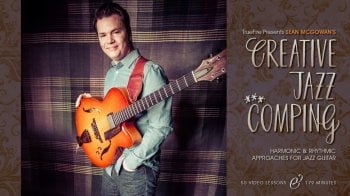 25 April 2022 | 5.72 GB
25 April 2022 | 5.72 GB
Harmonic & Rhythmic Approaches for Jazz Guitar
The sophistication and improvisational nature of jazz, with its complex and swiftly moving chord progressions, is what attracts guitar players to the genre despite its steep learning curve. Jazz guitarists must develop a considerable vocabulary of chord voicings, along with a solid understanding of harmonic and rhythmic devices, to confidently hang in the rhythm section supporting vocalists and soloists.
Sean McGowan’s Creative Jazz Comping is designed to help organize and simplify the process of learning, memorizing, and applying chordal ideas and comping strategies in a modern jazz context.
“I’ve organized this course into 6 sections. In the first section, we’ll start by discussing comping and its importance in jazz, some recommended listening, as well as a few exercises to get our hands ready for all the chords we’ll be learning. We’ll also look at different ways of articulating chord by exploring fingerstyle techniques, hybrid picking, strumming, and using the thumb.”
“There are some talented Jazz instructors on TrueFire and Sean McGowan is right up there with them. His method is so relaxed he makes what he does look effortless. Economy of movement and great teaching insights make this a great pathway into the realm of the jazz guitar greats.” – David Parker, TrueFire Student
Section 1 lessons include: Jazz Comping Philosophy, Listening for Jazz Comping, Warm-Up & Stretching, and Jazz Comping Articulation.
In the second section, Sean introduces a system that makes it easy to learn and utilize chord shapes based on Guide Tones and extensions. ”I’ll show you how to build – and more importantly – understand and apply numerous chord voicings, without memorizing a bunch of random shapes. The guide tone system will provide a two-tiered approach to simplify the fretboard, and better understand the function and use of extensions within complex chord voicings.”
Section 2 lessons include: Guide Tone Voicings: Root 5 & 6, GT+1 Voicings: One Extension, GT+2 Voicings: Two Extensions, Guide Tone Voicings for a ii-V-I, Guide Tone Horizontal Inversions, and Guide Tone Vertical Inversions.
In the 3rd Section, you’ll explore the middle register of the guitar with Phat Philly voicings and learn ways to create motion in your comping. ”I’ll show you an alternative approach to the guide tone system that explores the middle register of the guitar, focusing on strings 5-2, and learning voicings that sound great in a blues/soul jazz context.”
Section 3 lessons include: Phat Philly Voicings, Phat Philly Voicings for a ii-V-I, Triangle Shapes, Triangle Shapes for a ii-V-I, and Figure Eight Shapes.
Section 4 focuses on Triad Hybrids and Slash Chords. ”Yet another way to approach comping and chord voicings – especially in a modern jazz context – is by using slash chords and triad hybrid structures. This approach will really breathe some new life into well-worn standards, and offer a fresh approach to tunes you already know and play.:
Section 4 lessons include: Slash Chord Voicings, and Slash Chord Applications for a ii-V-I.
Section 5 drills down on swing rhythms and syncopation techniques to spice up your playing. ”Undoubtedly, one of the most important aspects of effective comping is rhythmic acuity, a solid understanding of syncopation devices and techniques, and helping the song – and soloist – swing in your role as an accompanist.”
Section 5 lessons include: Rhythmic Philosophy, Using Anticipation, Delayed Attack, Combining Anticipation & Delayed Attacks, The Charleston Rhythm, Charleston Variations, and The Jazz Waltz.
“One of the best players and teachers on TrueFire. This guy knows his stuff.” – Nimeu, TrueFire Student
In the 6th and final section, you’ll apply all the concepts and techniques from the previous sections over 6 comping performance studies. “We’ll combine all of our Creative Comping techniques and concepts and comp over six studies based on popular progressions used in classic and contemporary jazz styles.”
Sean will explain and demonstrate all of the key concepts and approaches along the way. You’ll get standard notation, tabs, and diagrams for the key examples and performance studies. Plus, Sean includes all of the rhythm tracks for you to work with on your own. In addition, you’ll be able to loop or slow down any of the performances so that you can work with the lessons at your own pace.
Grab your guitar and let’s get creative with Sean McGowan!
转载请注明:0daytown » Truefire Sean McGowan’s Creative Jazz Comping Tutorial